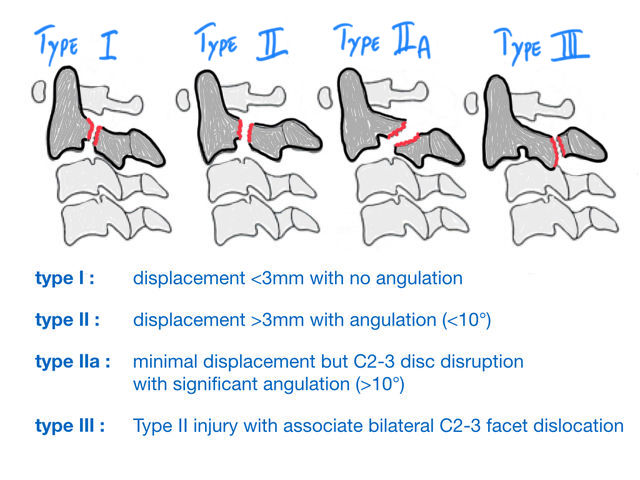Edited by Brendan Striano, Grace Xiong, and Harry Lightsey - 7/1/2021
Most Common Fracture Types
Dens Fractures (Odontoid Process Fracture)
Traumatic Spondylolisthesis of C2 (Hangman Fracture)
Exam Pearls
Ensure patient is in well-fitted C-collar
Full BUE and BLE Neuro exam
-Strength, Sensation, Reflexes, Hoffman, Babinski, Clonus, Rectal Tone +/- Bulbocavernosus, Tenderness to palpation; Spine Exam
-Good to get RN early because will need help with rolling pt for rectal / spine palpation
Workup
Radiographs: CT Cervical Spine (the majority of these consults will come having been diagnosed on CT)
Other imaging:
-if definitively non-operative, obtain upright (standing or sitting) XR Cervical Spine (AP + Lat) in ED or prior to discharge (for clinic comparison)
-MRI C-Spine (stat) if there is neurologic deficit warranting further investigation
-CT Angiogram Neck or MR Angiogram Neck - indicated if there is injury that extends into the Transverse foramen (potential vertebral artery injury). If vertebral injury present, most pts asymptomatic, but good to know if pt is dependent on their remaining Vertebral artery in the event pt needs surgery. Requires either a Vascular Surgery or Neurosurgery consult (depending on where the injury is / locoregional patterns of who “owns” the vertebral artery)
Labs: Pre-op labs (in case injury is operative)
Other: Need to identify whether pt takes chronic anticoagulation
Management
Need for acute intervention:
Yes, all C2 Fracture need immediate immobilization with C-collar
Some Fracture patterns can be definitively managed with C-collar
Acute neurologic compromise requires urgent surgical intervention
Injury Based Treatment Decision:
Dens Fractures
3 Types:
Type I - Odontoid Tip Fx - represents Alar ligament avulsion - Typically all are treated conservatively with C-collar
Type II - Odontoid Fx through waist
-Young pts w/ Type II typically get surgical intervention
-Elderly w/ low E Type II are controversial, data for both conservative and operative.
In Boston, essentially all geriatric Type II get C-collar
Type III - Odontoid Fx extending into the C2 body +/- the C1-2 Articulation: Typically all treated with C-collar
-There is a Type III variant that extends into the pars and looks like a cross between a Type III Dens and a Hangman...these are also well-treated with C-collar immobilization

Traumatic Spondylolisthesis of C2 (Hangman Fractures): Pars fx occurring between C1-2 and C2-3 Articulations
4 Types of Hangman Fractures
Type I: Managed with C-collar
Type II: Often need surgical intervention. Some advocate for ED / OR traction assisted reduction
This warrants an overnight call to Fellow/Attending as may need overnight intervention
Type IIa: Not to be reduced with traction. Can be treated with axial load and extension
This warrants an overnight call to Fellow/Attending as may need overnight intervention
Type III: Requires reduction and surgical intervention
This warrants an overnight call to Fellow/Attending as may need overnight intervention

Weight-bearing and range of motion: if managing definitively with C-collar, it should be maintained at all times
Type of immobilization: C-collar
Admission or discharge status:
-if definitively non-operative, OK to get XR Cervical spine in ED and discharge patient
-Many of these injuries will occur in elderly geriatric patients who, even if fracture is safe for discharge, will need PT assessment, possible placement from ED or even admission
Anticoagulation: Does not need anticoagulation for this injury. If pt w/ c-spine injury needs anticoagulation for another reason (e.g. - risk of life or limb), need discussion between spine team and team desiring anticoagulation.
Factors to consider: need for surgical intervention for spine, likelihood to develop epidural hematoma because of injury v. risk of deterioration if not given anticoagulation
Antibiotics: None needed
Surgical Indications
Absolute:
Dens Fractures: Type II Dens Fracture in a Young, Active person
Hangman Fracture: Type III Hangman or Neurologic Compromise
Relative: None
Not an indication: None